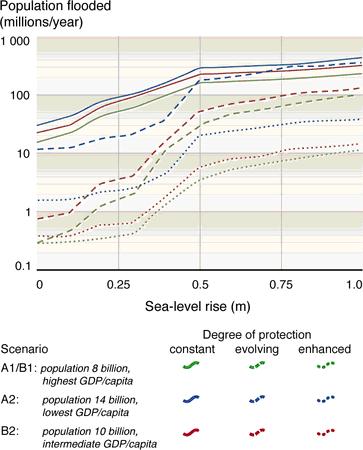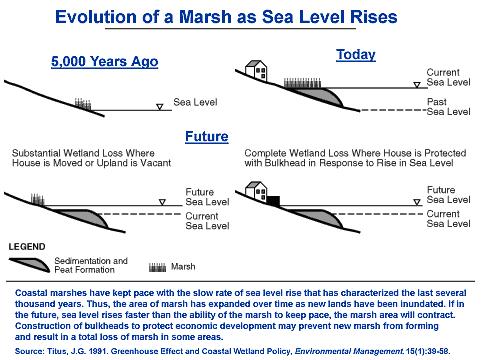Повышение уровня моря будет ощущаться как за счет изменения среднего уровня моря, так и, что более важно, в результате изменений экстремальных событий на уровне моря. Даже если в экстремальных погодных условиях нет изменений (например, нет увеличения интенсивности тропических циклонов), повышение уровня моря приведет к более частым превышениям экстремальных уровней моря. Это увеличение частоты экстремальных событий уже наблюдается во многих местах. Увеличение частоты экстремальных явлений будет зависеть от местных условий, но события, которые в настоящее время происходят раз в 100 лет, могут происходить к 2100 году раз в несколько лет.
Даже без учета увеличения частоты экстремальных явлений, в течение следующего столетия на миллионы людей будут влиять прямые последствия повышения уровня моря. Большие изменения уровня моря в последние несколько ледниковых периодов иногда используются, чтобы уменьшить важность относительно небольших текущих изменений уровня моря, ссылаясь на то, что человечество адаптировало к этим изменениям в прошлом, и оно должно быть способным адаптироваться снова. Очевидная ошибка этого аргумента состоит в том, что ранее жители региона взяли бы все свои пожитки и пошли в более подходящее место, когда изменения уровня моря сделали бы их нынешнюю среду обитания невозможной для жизни. При современной инфраструктуре (например, Лондон и Нью-Йорк), которые расположены вблизи уровня моря, и для многих миллионов людей, живущих в районах, находящихся под угрозой исчезновения (например, Бангладеш и Южный Вьетнам), такое решение недоступно.
Физические эффекты повышения уровня моря можно классифицировать как потерю земли из-за затопления низменных районов, эрозии пляжей и берегов, вторжение соленой воды в водоносные горизонты и поверхностные воды, повышение уровня грунтовых вод и увеличение частоты наводнений и ураганов.

A rise of a few mm per year by the sea, although not threatening spectacular inundation is still extremely important. Direct land loss of low lying areas can rapidly (decadal to centennial periods) damage or destroy coastal ecosystems. Rising sea levels inundate wetlands and other low-lying lands, erode beaches, intensify flooding, and increase the salinity of rivers, bays, and groundwater tables. Some of these effects may be further compounded by other effects of a changing climate.
Coastal wetland ecosystems, such as salt marshes and mangroves are particularly vulnerable to rising sea level because they are generally within a few feet of sea level (IPCC, 2007). Wetlands provide habitat for many species, play a key role in nutrient uptake, serve as the basis for many communities’ economic livelihoods, provide recreational opportunities, and protect local areas from flooding.

As the sea rises, the outer boundary of these wetlands will erode, and new wetlands will form inland as previously dry areas are flooded by the higher water levels. The amount of newly created wetlands, however, could be much smaller than the lost area of wetlands — especially in developed areas protected with bulkheads, dikes, and other structures that keep new wetlands from forming inland. The IPCC suggests that by 2080, sea level rise could convert as much as 33 percent of the world’s coastal wetlands to open water. (IPCC, 2007). Tidal wetlands are generally found between sea level and the highest tide over the monthly lunar cycle. As a result, areas with small tide ranges are the most vulnerable.
In addition to inundation, long-term sea level rise can cause erosion and shoreline retreat by creating a sediment budget deficit. Coastal erosion is caused by a variety of factors, which broadly fall into two categories. First, sand often migrates along the shore, causing some areas to erode and others to accrete. Second, rising sea level causes virtually all shores to erode. Using a model first developed by Danish coastal engineer Per Bruun, coastal geologists have estimated that a one-meter rise in sea level will cause beaches to erode 50 to 100 meters from New England to Maryland, 200 meters along the Carolinas, 100 to 1000 meters along the Florida coast, and 200 to 400 meters along the California coast. These model calculations are roughly consistent with the observed rate of erosion. (http://www.cmar.csiro.au/sealevel)
The effect of rising mean sea levels will be felt most profoundly during extreme storm conditions when strong winds and falling pressure bring about a temporary and localised increase in sea level known as a storm surge. Storm surges occurring on higher mean sea levels will enable inundation and damaging waves to penetrate further inland increasing flooding, erosion and the subsequent detrimental impacts on built infrastructure and natural ecosystems. In the tropics storm surges are caused by tropical cyclones while elsewhere mid-latitude storms and their associated cold fronts are the main cause of storm surges.
Sea level rise also increases the vulnerability of coastal areas to flooding during storms for several reasons. First, a given storm surge from a hurricane or northeaster builds on top of a higher base of water. Considering only this effect, it is estimated that existing development in the U.S. Coastal Zone would experience a 36-58 percent increase in annual damages for a 30 cm rise in sea level, and a 102-200 percent increase for a 1 m rise. Shore erosion also increases vulnerability to storms, by removing the beaches and dunes that would otherwise protect coastal property from storm waves (FEMA 2000). Sea level rise also increases coastal flooding from rainstorms, because low areas drain more slowly as sea level rises.
Other impacts of climate change may further enhance or mitigate coastal flooding. Flooding from rainstorms may become worse if higher temperatures lead to increasing rainfall intensity during severe storms. An increase in the intensity of tropical storms would increase flood and wind damages.
Rising sea level increases the salinity of both surface water and ground water through salt water intrusion. If sea level rise pushes salty water upstream, then the existing water intakes might draw on salty water during dry periods. Salinity increases in estuaries also can harm aquatic plants and animals that do not tolerate high salinity. Shallow coastal aquifers are also at risk (IPCC, 2007). As rising water levels submerge low-lying portions of the coastal areas, portions of the aquifers would become saline.
All the mentioned impacts of sea level rise can cause human loss due to increased level of storm surges, socio-economic losses of coastal communities as well as impact on national economies, environmental problems such as loss of wetlands, dunes and associated ecosystem habitats and loss of cultural heritage due to inundation of these sites (http://epa.gov/climatechange/effects/coastal/index.html).